IM 70.3 Cascais - Race retro
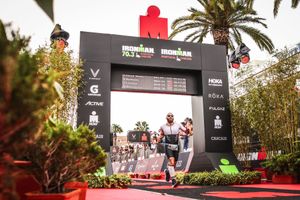
Last weekend (October 21, 2023), I raced the Ironman 70.3 at Cascais, Portugal. If you are not familiar with the format of an Ironman 70.3 race, it is a long-distance triathlon: 1900 meters of swimming, followed by 90 km of cycling and 21 km of running. This post would be a breakdown of my experience during the race.
Leading up to the race
After Jönköping last year, I had originally planned to do at least 3 events in 2023. Sadly, life happened, and I had to roll with the punches. So, I went ahead and transferred to Cascais.
Fast forward several months, and many many hours of training later, I managed to get back to a decent fitness level. However, closer to race week, work got in the way. Having to balance a stressful week while also trying to get into the right mindset was challenging. In retrospect, I should ask for a full week of vacation leading up to the race. To ensure that I'll have the time and focus to settle into race mode. Watch my nutrition, my sleep, and most importantly my confidence.
Cascais as a host city
I had originally planned to race IM 70.3 Venice-Jesolo back in May. But as mentioned above, I couldn't race it since I had some Swedish residency issues, barring me from travel. Therefore I had to transfer my entry to an event that I knew was late enough on the season for my permit to arrive.
Hence, Cascais was a nice option, since it was in late October (one of the latest available races for Europe). Boy, it didn't let me down.
Cascais is a great venue for an IM (both full and 70.3):
- The weather is just perfect. Not too hot, not too cold
- The route in itself is quite challenging (more on that later), but its scenery is just great
- Just 30-40 mins outside Lisbon airport, it is quite easy to get there (around 40 EUR for a taxi that could transport my bike)
- Great food and sightseeing, especially if you are traveling with family or friends. On an unrelated note, don't overstay at Lisbon and try to make it to Porto. Lisbon is nice, but don't spend more than 2 days at it.
Pre-race: logistics, registration, and transition set-up
Registration was quick and smooth. I particularly enjoy how nowadays they print all the stickers right at registration. So it feels quite nice to see the process happening before your eyes. Giving me the confidence that there would be no surprises with my race kit. I could watch how they put inside the backpack the 3 transition bags (blue for the bike, red for the run, and white for street clothes), my race stickers, and my swimming cap. So, after putting my gear on their respective bags, and grabbing my bike, I headed to the transition zone.
Transition was also quite smooth. Interestingly enough, the transition is divided into two platforms. So it gets let's hectic, to be honest. It was wide and very well organized. The only "downside" was the long queue to get into the transition zone. Luckily, it moved fast.
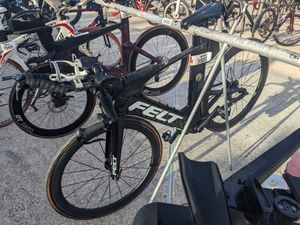
What wasn't so smooth? Logistics. Especially around nutrition. A big learning point here would be to also look at and plan nutrition for those couple of days before the race. It mind sound trivial, but even planning the supermarket run is critical to avoid unnecessary stress. Especially not having water around and risking dehydration.
Note to future self. Next time, get an earlier flight, make sure to arrive on time, and get to the grocery store first. Don't just buy a couple of things, buy enough so it'll last all your stay. Specially water. At least 10 liters.
Race day
Early wake up, breakfast & transition check
An early race start always means an even earlier alarm. This time it woke me up at 04:30 AM. Barely enough time to have some breakfast, coffee and make sure that I've visited the bathroom before heading out of the door.
One fun fact about Cascais is that it is extremely easy to walk around it. However, at 6:30 AM when all nerves were through the roof, adding 30 mins of walking towards transition was not an option. Thankfully, right in front of our AirBnB, we had access to some Bird electric bikes for hire. So, after fiddling with the bikes, I was there in transition in just 7 minutes or so.
So, there I was. At 6:40-ish AM inside the transition zone. With my trusty pump at hand, I went straight to check the pressure of my tires. This was my first time using (and racing) with latex tubes. So I wanted to be 100% sure that the pressure was at the right level. Hence, bringing my pump along was the right call. Thankfully, if you put one of the extra race stickers on your pump, the volunteers make sure to collect it so it can be checked out after the race.
After checking my bike, setting up my nutrition, checking up my bags, and taking I deep breath... I was ready. One last visit to the portable potties and I was golden to head to the swim start.
The swim
The swim start at Cascais was amazing. The announcer had a very moving speech about what it took to be there racing. I remember barely being able to hold back my tears. So after waiting a little for my 35-minute starting pack to start heading out, my race started.
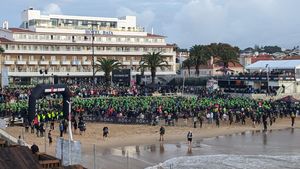
Cascais swim was a very simple single loop around a harbor. There were plenty of buoys for visibility and the course itself was very simple to follow. At least on paper.
My experience was less than optimal. Despite the water being relatively calm, I was not used to the chop. To be fair, this year I did 0 open-water swims. Yes, ZERO. To be fair, training in Stockholm isn't as pleasant as when I trained in the Dominican Republic. Especially around OW swimming.
I struggled with keeping oriented. I had trained my visibility and that wasn't the issue. The problem was staying on course. I don't know whether there was some sort of current or what, but each time I looked up, I was off-course. Which threw me out of my rhythm each time I found myself like that.
Despite all that, I managed to have a relatively good swim time. I was aiming for 35 minutes and I exited the water by the 38-minute mark.
Transition #1
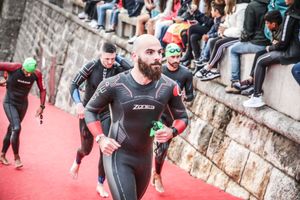
Cascais' swim course has a very special surprise after you get out of the water. A very steep transition run. I knew coming in, from watching many YouTube videos online, that I was going to run a bit uphill. But after swimming 1.9 kilometers, is a different story.
Nevertheless, I kept my calm. As soon as I started heading up the ramp, I took away my goggles and swim cap, and when I was coming off the first hill, my wetsuit was already around my waist. Goggles and race cap inside one of the sleeves. So I won't have to worry about them when throwing the wetsuit inside the blue bag.
Once I got to the racks holding the T1 bags, I took mine, took out my bike gear, and threw inside the wetsuit. My bike gear was simply my helmet, which has the visor already attached to it, and my cycling shoes. Therefore I was able to be done with the blue bag pretty quickly. But now I had to get to my bike.
If you look at my overall time on T1, you'll see a whopping 8 minutes a 17 seconds. As my wife jokingly asked me, was I getting my nails done there? See, the thing is, Cascais' transition was huge. From the moment you get out of the water to the entrance of T1 is around 600 meters or so (I don't know exactly, but it surely felt like it). However, the actual transition zone was around 300 meters. So if you do the math, at an easy 6:00 min/km pace, it would mean that I only took around 2 minutes inside transition to be ready. So no, I wasn't doing my nails, I was basically doing a mini-race in there.
The bike
So after those 8:17 minutes, I was ready to take on the bike. I headed out of T1 strong like a bull. Which only lasted a couple of kilometers hahaha.
Cascais' early bike course was very hilly. As you can see on the elevation profile, the race is pretty much divided in thirds. The first third is where the hills were. The second was more of a rolling hills profile. But the last third is where the speed gains were.
My experience was very similar. The first part of the bike section was mostly a mind game. I had to remind myself that, despite going slow, I was in for the long run. I watched my power on the hills while making sure to keep my nutrition on point.
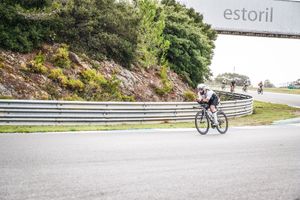
One welcomed break from the steep hills was the Estoril race track. As it turns out, the Cascais bike course has a ~4 km section inside the Estoril F1 race track. Despite not being flat, it was possible to get fast in there. Kind of a preamble on how the race was about to be laid out.
After the first third of the race, I was averaging between 25-27 kph. Not "bad", but it was disappointing to see. But it was all about to change since the hills were over. A steep descent section came by and I was already flying into the high 50s. As mentioned before, this second section was rolling, so despite the speedy descends, there were still some hills and turns that made this part a bit technical. Again, I just kept my head in the game and waited until I knew I could let the animal out.
When I reached the 60+ km mark, I knew I was ready to put my foot on the gas. The rolling section was over and I was getting to the turnaround section at Lisbon. From this point onwards, it was mostly flat, so I pressed on. My speed was around 34+ kph, and I was determined to recover my average speed to something closer to 31 kph. I pushed on and made it happen. Once I was back in Cascais, getting ready to undo my cycling shoes, I looked at my bike computer and I was satisfied with the result, 31 kph average speed.
Transition #2
After those 90 kilometers, there I was again, running through transition. This time I took it very relaxed. I knew that on my previous 70.3 races, I went through T2 and started my run with an elevated heart rate. So, for this race, I knew I had to ramp into it slowly.
This all meant that I jogged alongside my bike until I left it at the designated rack. Fetched my red bag, took away my run gear, and placed my bike gear back inside the bag. Put on my bib, shades, and shoes and headed out for the run. But first, a little stop to the portable potties again. To make sure nothing distracts me when I start the run.
The run
In all my 70.3 races, the run is where I always fall off. So, this time I was determined to improve it. I trained hard for it. Did a lot of brick workouts and nutrition simulations to avoid gut distress (which had impaired me on my previous attempts). Unfortunately, this race was no exception. Despite all the training, I wasn't able to have a satisfying result.
For the first 2-3 kilometers I was focused on finding my legs. Surprisingly enough, by the 5-kilometer mark, my legs and pace felt good. Like really good. I was going at my target pace, without really feeling it. But I felt the very familiar gut pain there. Not as crippling as other races, but annoying enough to leave me fearful of consuming calories and making it worse.
So, by the 9-kilometer mark, I was looking at a finish time of around 5 hours and 45 minutes. Nothing impressive by normal standards, but for me, it was almost 20 minutes faster than my last race. I felt good. Until my legs sent a message to my brain. We are cramping.
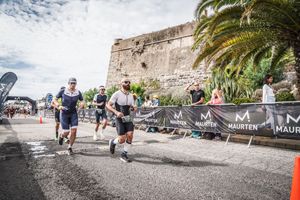
That's when I took a decision that, although seemed right at the moment, left me a bittersweet taste afterwards. I started to walk. More precisely, once I saw a hydration point, I walked the entire length of it. Which meant that every couple of kilometers, I walked around 300 meters or so. I might not sound as much, but those stops allowed me to recover from those initial hints of cramping. But at the same time hindered my possibility to improve my previous race result.
From that point onwards, I just went into full body management mode. Preventing cramping, gut distress, and watching my left knee for signs of pain (as I have an injury on that knee that tends to manifest during races). I wasn't racing anymore. I was enduring. Again, nothing wrong with it. But I want to finish a race feeling like I left everything in there. So far, the run has always taken that away from me.
The finish line
After swimming 1.9 kilometers, "doing my nails" on T1, 30-30-30 kilometers of hills, rolling hills and fast flats, plus 10 kilometers of running, followed by 11 of walk-run. I managed to hear my name as I was running down the finish line chute. Congratulations, Guillermo Velasquez, from Venezuela.
I was happy. I did it. I finished the race. I wasn't paying attention to the time at that moment. I knew I wasn't going to be impressed, but I was happy because, in the end, I finished without "crashing".
My legs didn't completely cramp. My gut didn't fully shut down and I was able to consume some calories while I walked through the hydration areas. And I finished it. I was done.
By the time I got my medal and proceeded to enter the finish area, I looked at my watch. 5:59:05. Again, bittersweet. To be honest, I was aiming for 5 hours and 30 minutes. Sure, it wasn't very realistic. But having just improved by some seconds from my previous race felt, shallow.
Now, after some days have passed, I can understand that was the result my body was able to execute that day. I haven't done anything exceptional during training to expect an exceptional result. On the contrary, I should feel grateful that none of the 3 common limiters of the past (my knee, my gut, or cramping) threw me off. So, if there's something to be learned here is that:
Next time, I'll do way better. Both in training and racing.
Spoiler alert, next time is on Aix-en-Provance, which has a VERY difficult course. So, if I want exceptional results, I'll have to put in exceptional efforts.